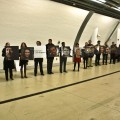Doha Gateway Until Now
Kahil Lloyd | November 13, 2013.
Since passing through the Doha Gateway, here is an update on some of the things that have happened.
1. The IPCC Fifth Assessment Report, AR5, released on 27 September 2013
AR5 is a damning scientific assessment of the state of the climate. Key among its conclusions was that humans are extremely likely the cause of global warming with 95 per cent scientific certainty and the only way to limit climate change is to substantially reduce greenhouse gas emissions.
The report has sparked an increased urgency in calling on action to be taken during Warsaw. The COP19 opening ceremony included a presentation from Dr Rajendra Pachauri, chair of the IPCC, and references to it by UNFCCC Executive Secretary Christiana Figueres. The science from the IPCC is clear, “parties can lead the momentum for change and move together towards success in 2015”. She implored delegates to act on the science in Warsaw.
Here are some highlights of the report.
2. Pre-COP Ministerial Meeting, 2-4 October 2013
Under the guidance of Polish Environment Minister Marcin Korolec, and now COP president, government representatives alongside leaders from the business sector converged in Warsaw to set the agenda for COP 19. This was the first time the business sector was involved. Korolec summarised the primary areas discussed at the meeting: climate finance, including how business could be involved; the 2015 agreement; post 2020 ambitions; and, the issue of loss and damage. These agenda items are being pursued at the Warsaw talks, setting the tone for a business friendly COP.
3. Intersessionals, various times throughout 2013
In June of this year, parties met in Bonn for an intersessional meeting; progress was mixed.
Three bodies convened at the talks in Bonn: the Subsidiary Body for Implementation (SBI); the Subsidiary Body for Scientific and Technological Advice (SBSTA); and the Ad-Hoc Working Group on the Durban Platform for Enhanced Action met (ADP). SBI and SBSTA are the two main working groups of the Convention. SBI assesses andreviews the implementation of the Convention and Kyoto Protocol, whilst SBSTA provides timely information and advice on relevant scientific and technological matters.
In Doha, the agreement was passed despite Russia’s loud objections. In response to this treatment, Russia blocked any progress being made in SBI at the meeting. Parties at Warsaw will struggle to do the work of two SBI sessions in one sitting.
Because no substantive negotiations occurred under SBI, the various tracts under SBSTA were allocated more negotiating time slots. SBSTA made good progress in a number of areas: in particular REDD+ in terms of conservation and forest carbon stocks, as well as methodological issues.
The ADP struggled to create consensus, and much like the SBI, progress was limited. Parties have much work to do under these work streams, be prepared for long nights.
4. Durban Platform
Parties made submissions to the Durban Platform in relation to the proposed agreement for 2015. The co-chairs have compiled five key areas from these submissions that will be discussed at Warsaw: mitigation; adaptation; finance; technology development and transfer; and, capacity building and transparency.
Parties agree that the working group needs to move from defining general concepts to detailing specific content for the new treaty. Expect movement in all key areas, but keep your expectations for Warsaw low as there is still no consensus on next steps.
5. Domestic Politics
Domestic politics determines a country’s position at the UNFCCC. After all, diplomats can only negotiate within their mandate, and progress is either facilitated or hampered by these positions. This year has seen a number of domestic changes for countries including Germany, China, and Japan. The country whose recent election will most directly impact the process is Australia.
In September Australia’s government changed, and the conservative Coalition led by Tony Abbott was elected. The new government is committed to the same five per cent emission reduction target, but is intent on repealing the carbon price; a piece of legislation that actually could have delivered that reduction. Their plan is to instead replace this with their Direct Action Plan.
Specific details of the policy are yet to be finalised, however independent modelling suggests that the funds allocated are not enough to reach the five per cent target, let alone scaling up ambition. There is fear that Australia is setting a precedent for other parties to assume inadequate pledges.
By Kahil Lloyd, Holly Jones and Andrés Fuentes; photo by Laura Owsianka.











comment